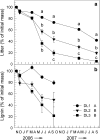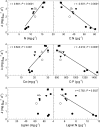Leaf litter decomposition in temperate deciduous forest stands with a decreasing fraction of beech (Fagus sylvatica)
- PMID: 20596729
- PMCID: PMC2981742
- DOI: 10.1007/s00442-010-1699-9
Leaf litter decomposition in temperate deciduous forest stands with a decreasing fraction of beech (Fagus sylvatica)
Abstract
We hypothesised that the decomposition rates of leaf litter will increase along a gradient of decreasing fraction of the European beech (Fagus sylvatica) and increasing tree species diversity in the generally beech-dominated Central European temperate deciduous forests due to an increase in litter quality. We studied the decomposition of leaf litter including its lignin fraction in monospecific (pure beech) stands and in stands with up to five tree genera (Acer spp., Carpinus betulus, Fagus sylvatica, Fraxinus excelsior, Tilia spp.) using a litterbag approach. Litter and lignin decomposition was more rapid in stand-representative litter from multispecific stands than in litter from pure beech stands. Except for beech litter, the decomposition rates of species-specific tree litter did not differ significantly among the stand types, but were most rapid in Fraxinus excelsior and slowest in beech in an interspecific comparison. Pairwise comparisons of the decomposition of beech litter with litter of the other tree species (except for Acer platanoides) revealed a "home field advantage" of up to 20% (more rapid litter decomposition in stands with a high fraction of its own species than in stands with a different tree species composition). Decomposition of stand-representative litter mixtures displayed additive characteristics, not significantly more rapid than predicted by the decomposition of litter from the individual tree species. Leaf litter decomposition rates were positively correlated with the initial N and Ca concentrations of the litter, and negatively with the initial C:N, C:P and lignin:N ratios. The results support our hypothesis that the overall decomposition rates are mainly influenced by the chemical composition of the individual litter species. Thus, the fraction of individual tree species in the species composition seems to be more important for the litter decomposition rates than tree species diversity itself.
Figures






References
-
- Ad-hoc-Arbeitsgruppe Boden (2005) Bodenkundliche Kartieranleitung. Schweizerbart’sche Verlagsbuchhandlung, Stuttgart
-
- Aerts R. Climate, leaf litter chemistry and leaf litter decomposition in terrestrial ecosystems: a triangular relationship. Oikos. 1997;79:439–449. doi: 10.2307/3546886. - DOI
-
- Ayres E, Steltzer H, Berg S, Wall DH. Soil biota accelerate decomposition in high-elevation forests by specializing in the breakdown of litter produced by the plant species above them. J Ecol. 2009;97:901–912. doi: 10.1111/j.1365-2745.2009.01539.x. - DOI
-
- Ayres E, Steltzer H, Simmons BL, Simpson RT, Steinweg JM, Wallenstein MD, Mellor N, Parton WJ, Moore JC, Wall DH. Home-field advantage accelerates leaf litter decomposition in forests. Soil Biol Biochem. 2009;41:606–610. doi: 10.1016/j.soilbio.2008.12.022. - DOI
-
- Ball BA, Hunter MD, Kominoski JS, Swan CM, Bradford MA. Consequences of non-random species loss for decomposition dynamics: experimental evidence for additive and non-additive effects. J Ecol. 2008;96:303–313. doi: 10.1111/j.1365-2745.2007.01346.x. - DOI
Publication types
MeSH terms
Substances
LinkOut - more resources
Full Text Sources
Miscellaneous

